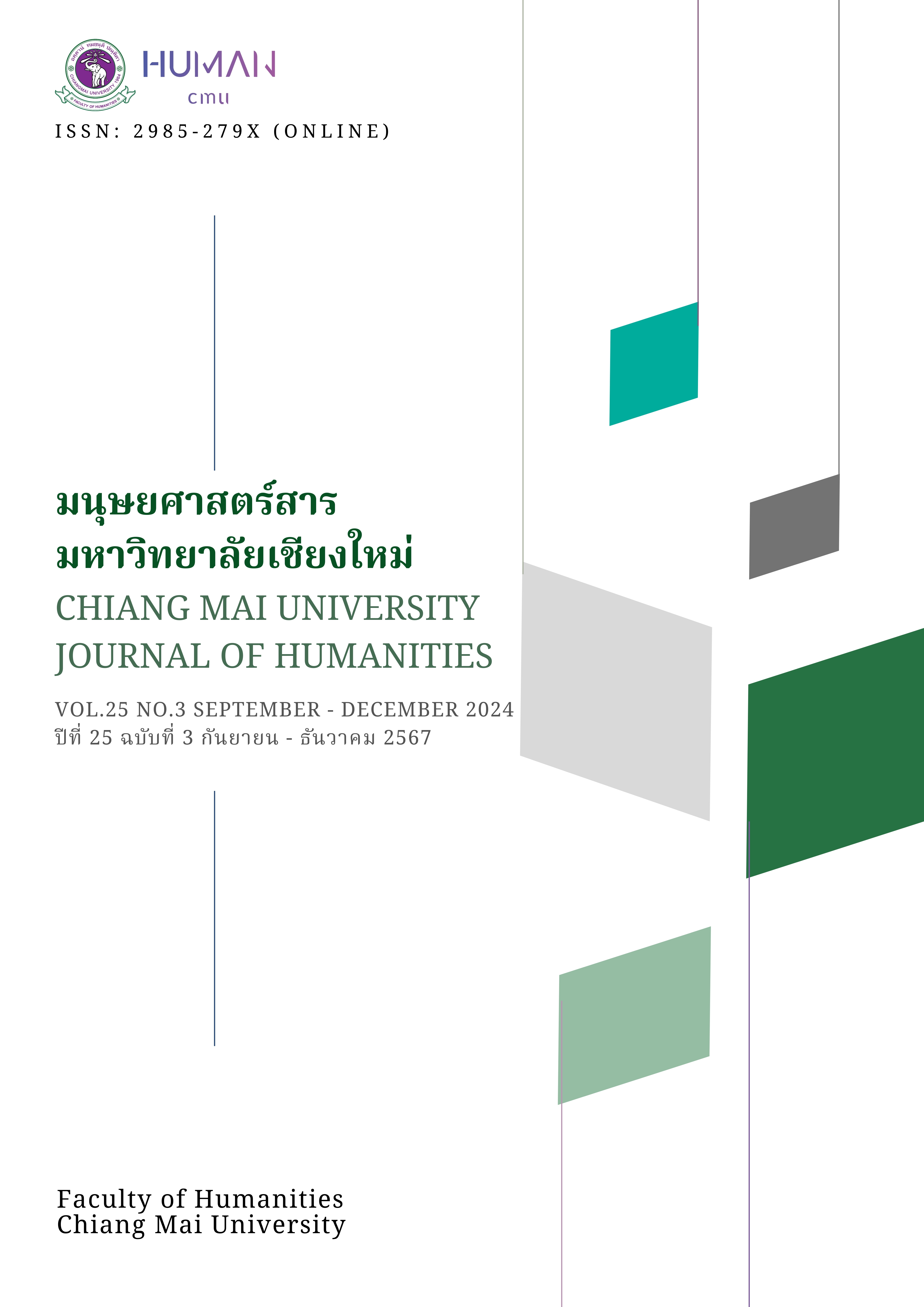ภาพสะท้อนวัฒนธรรมการ “ดื่ม” ของชาวจีนผ่านภาพยนตร์ เรื่อง别叫我酒神 (Don’t call me Bacchus)
Main Article Content
บทคัดย่อ
การศึกษานี้เป็นการศึกษาเชิงคุณภาพมุ่งศึกษาภาพสะท้อนวัฒนธรรมการดื่มของชาวจีนผ่านภาพยนตร์จีนเรื่อง别叫我酒神(Don’t call me Bacchus)และวิเคราะห์บทบาทของ”เหล้า” ในวัฒนธรรมจีน ผลการศึกษาพบว่า เนื้อหาของเรื่องได้สะท้อนภาพวัฒนธรรมการดื่มได้ 4 ด้าน ได้แก่ 1) การสะท้อนภาพแบบแผนจารีตในการดื่มเหล้าของชาวจีน 2) การเชื้อเชิญให้ดื่ม 3) ความหลากหลายของชนิดเหล้า และภูมิปัญญาในการผลิตเหล้า 4) ความหลากหลายของธรรมเนียมในการดื่มของแต่ละพื้นที่ ในด้านบทบาทของเหล้าในวัฒนธรรมที่ถูกสะท้อนผ่านเนื้อเรื่องจากผลการวิเคราะห์พบว่าเหล้านั้นมีบทบาทใน 2 ลักษณะ ได้แก่ 1) การใช้เหล้าเป็นตัวกลางเพื่อเชื่อมสัมพันธ์ระหว่างเพื่อนฝูง 2) การใช้เหล้าเป็นเครื่องมือในการเจรจาทางธุรกิจ ในด้านการสะท้อนแนวคิดและวิถีชีวิตชาวจีนในสภาพสังคมปัจจุบันที่เกี่ยวเนื่องกับวัฒนธรรมการดื่ม พบว่า 1) ภาพยนตร์ได้สะท้อนสภาพวิถีชีวิตความเป็นอยู่ของผู้คนในพื้นที่ที่เป็นฉากของเรื่องผ่านภาษาถิ่น สถานที่และยานพาหนะอันเป็นเอกลักษณ์สำคัญของพื้นที่ 2) การนำเสนอภาพความเปลี่ยนแปลงของผู้คนในยุคปัจจุบันที่เศรษฐกิจมีความเปลี่ยนแปลงภายใต้ระบอบการปกครองของจีน 3) อิทธิพลของวัฒนธรรมที่แทรกซึมอยู่ในตัวละคร 4) การกินดื่มในปัจจุบันที่มีความเปลี่ยนแปลงไปจากวัฒนธรรมในอดีตซึ่งส่งผลมาจากการเปลี่ยนแปลงทางเศรษฐกิจและสังคมและผลเสียที่เกิดขึ้น ผลการศึกษายังชี้ให้เห็นว่าวัฒนธรรมความเชื่อ ปรัชญา ของจีนนั้นได้เข้าไปมีบทบาทสำคัญในการดำรงชีวิตในสังคมจีน สะท้อนผ่านกิจกรรมต่าง ๆ ไม่ว่าจะเป็นเรื่องของ มารยาท ธรรมเนียม วิธีปฏิบัติ
Article Details

อนุญาตภายใต้เงื่อนไข Creative Commons Attribution-NonCommercial-NoDerivatives 4.0 International License.
เอกสารอ้างอิง
กาญจนา แก้วเทพ. (2537). วิจารย์หนังทัศนะใหม่2. เจนเดอร์เพรส
คณะอนุกรรมการพิจารณาเกณฑ์การถ่ายทอดเสียงภาษาจีนเป็นภาษาไทย. (2543). เกณฑ์การถ่ายถอดเสียงภาษาจีนแมนดารินด้วยอักขรวิธีไทย. มหาวิทยาลัยธรรมศาสตร์.
ณัฐวุฒิ มีสกุล. (2562). การถ่ายทอดวัฒนธรรมเกาหลีผ่านสื่อละครเกาหลี. วารสารนิเทศสยามปริทัศน์,
(2), 206-218
ดุษฎี วรธรรมดุษฎี. (2556). วัฒนธรรมกับการดื่ม. วารสารราชพฤกษ์, 10(3), 13-20
นิโลบล วงศ์ภัทรนนท์. (2564). จาก ลอดลายมังกร สู่เลือดข้นคนจาง: การนำเสนออัตลักษณ์ทางวัฒนธรรมความเป็นชาวไทยเชื้อสายจีนในละครโทรทัศน์ไทย. วารสารวิชาการมนุษยศาสตร์และสังคมศาสตร์ มหาวิทยาลัยบูรพา, 29(2), 76-103
ปรีดา อัครจันทโชติ. (2561). ความเป็นจีนในโทรทัศน์ไทย. วารสารนิเทศศาสตร์, 36(1), 1-20
ปุรินทร์ นาคสิงห์. (2555). การประกอบสร้างตัวตนเกย์ในภาพยนตร์ไทย. [วิทยานิพนธ์ปริญญาดุษฎีบัณฑิต, มหาวิทยาลัยธรรมศาสตร์]. TUDC. https://digital.library.tu.ac.th/tudc/frontend/
Info/item/dc:93495
พลอยชมพู เชาวนปรีชาและ ฉลองรัฐ เฌอมาลย์ชลมารค. (2562). การประกอบสร้างภาพลักษณ์ประเทศไทยในภาพยนตร์ฮอลลีวูด. วารสารนิเทศศาสตรปริทัศน์, 23(3), 257-273.
ภัทรวดี ไชยชนะและองอาจ สิงห์ลำพอง. (2562). การสื่อสารภาพตัวแทนสตรีผ่านภาพยนตร์ไทย. วารสารมนุษยศาสตร์และสังคมศาสตร์ มหาวิทยาลัยราชพฤกษ์, 5(supplement), 130-143.
ภัทรภร ธัญญเสรี. (2553). ความเป็นจีนในการเล่าเรื่องของภาพยนตร์จีนแผ่นดินใหญ่ที่ฉายต่างประเทศ ระหว่างปี พ.ศ. 2534-2551. [วิทยานิพนธ์ปริญญามหาบัณฑิต, จุฬาลงกรณ์มหาวิทยาลัย]. CUIR. https://cuir.car.chula.ac.th/handle/123456789/20256
มนฑิรา ธาดาอํานวยชัย. (2565). ซีรีส์เกาหลีกับการสะท้อนภาพสังคมในปี 2563. วารสารนิเทศสยามปริทัศน์, 21(1), 229-240.
วรางคณา สุขม่วง และ องอาจ สิงห์ลําพอง. (2561). ภาพสะท้อนคนรักเพศเดียวกันในสังคมผ่านภาพยนตร์ไทย. รายงานการประชุม Graduate School Conference, 1(1), 954-962. http://journalgrad.ssru.ac.th/index.php/miniconference/article/view/1463
องอาจ สิงห์ลําพอง. (2557). การอภิปรายความการสื่อสารทางการเมืองจากภาพยนตร์อิง
ประวัติศาสตร์ไทยเรื่องตํานานสมเด็จพระนเรศวรมหาราช. สามลดา.
อนงค์นาฏ รัศมีเวียงชัย. (2560). ประเทศไทยในภาพยนตร์ต่างประเทศ. วารสารศาสตร์, 10(1),
-151.
Chen, Y. (2012). The Strategic Research on Narrowing the Face Gaps in Cross-cultural Communication [跨文化交际中拉近面子距离的策略研究]. Journal of Chongqing Three Gorges University, 1, 99-102.
Chu, J. (2009). Factors Which Affecting Business-to-Business Partnership Relationships within Chinese Culture Context [商务伙伴关系视野中的人际关系及其影响因素——基于中国文化背景的分析]. Journal of Henan Normal University (Philosophy and Social Sciences), 36(2), 128-131.
Deng, O. (2005). The Origin and Development of Kindness, Justice, Etiquette, Wisdom and Faith and Their Connotations [仁义礼智信"的由来、发展及其基本内涵(上)]. Journal of Changsha University, 6, 4-10.
Fang, T. (2003). A critique of Hofstede’s fifth national culture dimension. Journal of Cross Cultural Management, 3(3), 347-368.
Gao, F. (2011). The spiritual connotation of Chinese drinking culture [中国酒文化的精神内涵]. Journal of Shanxi Normal University (Social Science Edition), 38(3):120-122.
Gao, J. (2021). Beishanjiujing [北山酒经]. Chinese Literature and History, 11, 130-130.
Ghauri, P & Fang, T. (2001). Negotiating with the Chinese: A Socio-Cultural Analysis. Journal of World Business, 36(3), 303–325.
Hall, Stuart, ed. (1997). Representation: Cultural representations and signifying practices. Sage, 17-19.
Hang, L. (2011). Traditional Confucianism and its contemporary relevance. Asian Philosophy, 21(4), 437-445.
He, X.F. (2011). Renqing in an Acquaintance Society [论熟人社会的人情]. Journal of Nanjing Normal University(Social Science Edition), 4, 20-27.
Hoon-Halbauer, S. K. (1999). Managing relationships within sino-foreign joint ventures. Journal of World Business, 34(4), 344-371.
Huang, A. (2022, April 15). There is a breakthrough in the "high-quality" online movies [网络电影“精品化”有突破]. Guangzhou Daily. https://gzdaily.dayoo.com/pc/html/2022-04/15/content_879_789497.htm
Li, W. (1996). On Chnferring Favor:An Analysis of Social Interaction among Chinese People [论人情-关于中国人社会交往的分析和探讨]. Journal of Sun Yatsen University (Social Science Edition), 2, 57-64.
Li, W. (2013). etiquette of wine in sanli[《 三礼》 中的 “酒” 礼仪]. Journal of
Wenzhou Vocational and Technical College, 13(3), 74-76.
Liu, W. (2017). The Structural Disorder and Optimization of Chinese Drinking Culture[中国酒文化结构失调及优化]. Journal of Sichuan University of Science & Engineering (Social Sciences Edition), 32(1), 26-36.
Li, X. (2008). Analyzing usage of international business negotiation [浅谈国际商务谈判中礼仪的合理使用]. Journal of Heilongjiang College of Education, 11,
-131
Lin, l. (2011). The art and culture of drinking [劝酒的艺术和文化]. FaZhiZiXun, 11,
-20.
Liu, y. (2016). Chinese modern drinking etiquette culture [中国现代酒桌礼仪文化]. Tong Hang, 5, 161
Pearce, J. A., & Robinson, R. B. (2017). Cultivating guanxi as a foreign investor strategy. In
Tomasic, R.V. (Eds.), Commercial Law in East Asia (pp. 223-230). Routledge.
Research on the International Communication of Chinese Drinking Culture: The Differences in Domestic and Foreign Cultures [中国酒道文化国际传播研究之国内外酒文化的差异性]. (2021). Zhongguojiu, 3, 72-77.
Wang, H. (2013). wine and yeast making in Beishanjiujing [论《北山酒经》中的制曲及酿酒技术]. China Brewing, 32(7), 148-150. http://doi.org/10.3969/j.issn.0254-5071.2013.07.044.
Wang, Q. (2006). Strategy and effect of cultural difference in international business negotiation [国际商务谈判中文化差异的影响及对策]. Jiangxi Social Sciences, 6, 184-187.
Wang, Y., & Han, Y. (2020). Ethical dilemmas and solutions to China’s drinking culture [中国劝酒文化的伦理困境及解决对策]. Culture Journal, 7, 54-57.
Xiao, X. (2006). Yujiuling the culture of using fish to persuade people to drink [鱼酒令以鱼劝酒的文化]. Scientific Fish Farming, 9, 71-72.
Xu, S. (2012). Face Problem: the Cultural Difference Discussion in Cross-cultural Communication between China and the West [面子问题: 中西跨文化交际中的文化差异探讨]. Academy, 4, 58-63.
Xu, Y. (2018). Three Cultural Spirits of Chinese Traditional Festival Customs [中国传统节俗的三大文化精神]. Journal of North University of China (Social Science edition), 34(6), 1-8.
Xu, S. (2000). Chinese alcohol and traditional culture [中国酒与传统文化综述]. China brewing, 2, 5-9.
Yin, C. (2005). Front loader cargo tricycle [倒骑驴]. New Youth, 9, 46-47.
Zhao, J. (2005). Four famous Chinese wines-xifeng won 9 times international gold medal [中国四大名酒西凤酒九次夺得国际金奖]. Modern Enterprise, 9, 60.
Zhang, J. (2011). A brief analysis of Chinese drinking culture [浅析我国的酒桌文化]. Decision & Information, 11, 88-88.


